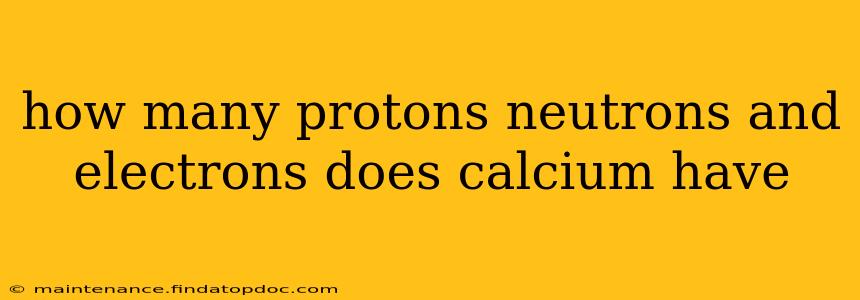Calcium, a vital element for human health and various industrial applications, is characterized by its specific atomic structure. Understanding the number of protons, neutrons, and electrons in a calcium atom is fundamental to grasping its chemical behavior and properties. This article will delve into the details, answering this key question and exploring related concepts.
What is the Atomic Number of Calcium?
The atomic number of an element defines the number of protons found in its nucleus. Calcium's atomic number is 20. This means that every calcium atom possesses 20 protons.
How Many Electrons Does Calcium Have?
In a neutral atom, the number of electrons equals the number of protons. Therefore, a neutral calcium atom also has 20 electrons. This balance of positive and negative charges results in a net charge of zero. However, it's important to note that calcium can lose electrons to form ions, a topic we'll explore later.
Determining the Number of Neutrons in Calcium
Unlike protons and electrons, the number of neutrons isn't directly given by the atomic number. The number of neutrons varies between different isotopes of an element. Isotopes are atoms of the same element with the same number of protons but different numbers of neutrons.
The most common isotope of calcium is Calcium-40 (⁴⁰Ca). The number after the element's name (the mass number) represents the total number of protons and neutrons. To find the number of neutrons, we subtract the atomic number (number of protons) from the mass number:
40 (mass number) - 20 (atomic number) = 20 neutrons
Therefore, the most common isotope of calcium, ⁴⁰Ca, has 20 neutrons. However, other calcium isotopes exist with differing neutron counts, such as ⁴²Ca, ⁴³Ca, ⁴⁴Ca, ⁴⁶Ca, and ⁴⁸Ca, each having a different number of neutrons.
How Many Neutrons Are in Other Calcium Isotopes?
Let's quickly calculate the neutron count for a couple of other Calcium isotopes:
- ⁴²Ca: 42 - 20 = 22 neutrons
- ⁴⁸Ca: 48 - 20 = 28 neutrons
As you can see, the number of neutrons can vary significantly even within the same element.
Calcium Ions: A Change in Electron Count
It's crucial to remember that the number of electrons can change when an atom forms an ion. Calcium readily loses two electrons to achieve a stable electron configuration, forming a Ca²⁺ ion (calcium cation). In this case, a calcium ion would have 18 electrons, two fewer than the neutral atom.
Summary: Protons, Neutrons, and Electrons in Calcium
To summarize:
- Protons: 20 (always the same for all calcium atoms)
- Electrons: 20 (in a neutral atom); 18 (in a Ca²⁺ ion)
- Neutrons: Varies depending on the isotope (20 in the most common isotope, ⁴⁰Ca)
This information is crucial for understanding calcium's reactivity, its role in biological systems, and its various applications in different fields. Understanding atomic structure is fundamental to chemistry and many other scientific disciplines.
